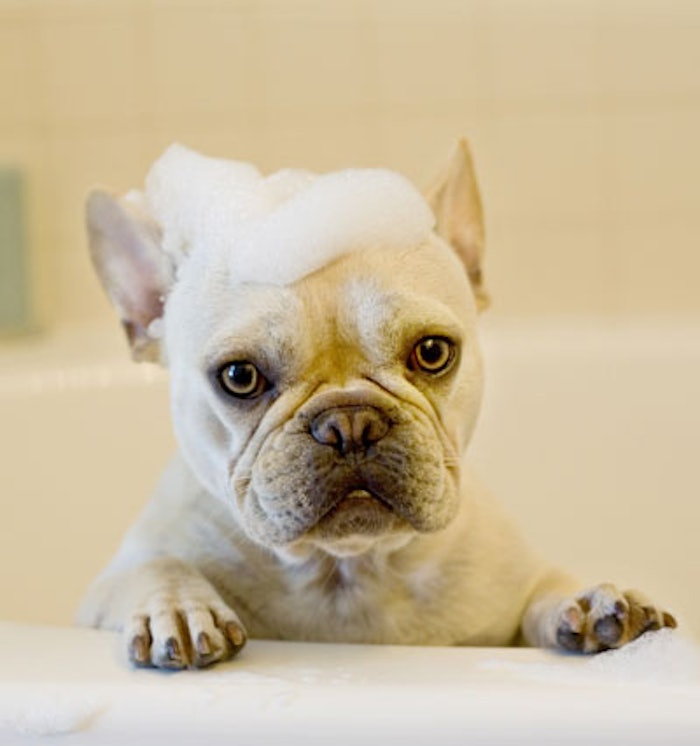
- The U.K. pet care segment, worth about $60 million, is forecast to increase by a compounded annual growth rate of 4.9% through 2009.
- Humanizing pet accessories will continue to be a major focus for pet care manufacturers who look to the fashion industry to draw inspiration for new products.
- Manufacturers focusing on pet health and wellness, including those expanding into nutricosmetics, will determine the future of the pet care segment.
- Retailers will provide one-stop shopping convenience for pet care products, in addition to offering services such as pet boarding, microchipping and animal matchmaking.
Celebrity hair stylist John Masters’ love of the animal kingdom may have flourished after adding Amber to his staff. The golden retriever spent the last 10 years of her life in the John Masters Organics SoHo salon in New York City, lying at the founder’s feet and greeting clientele. However, before Amber’s death in 2005 due to complications from cancer, Masters’ vision of sustainability, health and wellness transferred not only to his salon environment through the concept of an ammonia-free, “open-air” store, but also to his dogs—including his newest puppy, Maya.
“People who care to use the best in organic products for themselves usually want the same for their furry friends,” Masters says. “We took all of our knowledge in hair care, with many of the same ingredients, and created a formula for dogs.”
Washing dogs with the natural shampoo he created for his regular clients inspired Masters to expand his luxury organic hair and skin care brand into pet care, specially formulated for the pH level of dogs. Since his introduction to the beauty industry in the 1970s, Masters has taken his experience mixing organic essential oils and herbs in his kitchen sink to more than 30 total SKUs across 20 countries, including DogPoo, launched in April 2008. The playfully named, salon-developed shampoo, enhanced by citronella, tea tree and eucalyptus essential oils, promotes a shiny coat, free of fleas and ticks.
“Everyone kept asking me if I used my products on Maya, because she has a brilliant shiny coat,” Masters says, replying, “Of course I do.” With Masters’ dog in the salon each day, his customers soon began bringing in their dogs, too. This, in turn, grew his brand. Now Masters is looking into adding a dog coat conditioner and anti-odor shine spray to his pet care line. He hopes to pitch the ideas to his current distributors in independent pet shops across China, Japan and the U.K.
Global Distribution
Fortunately for Masters, the U.K. pet care market—including food, insurance and accessories—was worth $4.2 billion in 2004, according to The Pet Product Market in the United Kingdom, a July 2005 market research report by the U.S. Commercial Service, a division of the U.S. Department of Commerce. Since then, pet ownership in the U.K. has remained steady. Marcella Marcheso, commercial specialist for the U.S. Commercial Service in London’s American Embassy, believes that despite the lag in new pet adoption, owners will spend as lavishly on their pets as they would their children. In 2005 alone, sales of pet grooming and hygiene equipment in the U.K. reached more than $60 million. This number is forecast to increase by a compounded annual growth rate of 4.9% through 2009 for the entire pet care segment.
Most of the pet products in the U.K. are made in China, due to the country’s relatively low manufacturing costs. The U.S. accounts for a significant portion of imported products there, as well, according to the U.S. Commercial Service. However, U.S.-based niche organic pet care brands are also gaining in popularity, boosting domestic sales. As far as niche spa and boutique pet brands go, U.S.-based Spot Organics expresses similar organic values as Masters’ professional salon brand, expanding its handmade organic skin care remedies to help prevent canines’ itchy skin, bad breath, ear infections, anxiety, depression, motion sickness and flea infections. Kyla Sims, owner of Spot Organics, says her brand’s simple ingredient list makes a difference with her customers, who often include empty nesters with disposable incomes and young adults without children.
“We use common names for our ingredients so there is no confusion, and you know exactly what you are putting on or into your dog,” Sims says. Among the organic, plant-based ingredients used in her 4-oz. aromatherapy dog sprays or shampoo bars are blends of organic aloe vera, organic virgin olive oil and other ingredients commonly found in human personal care brands.
“The organic segment of the pet market is booming right now,” Sims says. “I think the pet food recall last year made a lot of people think about what they are putting into their dogs’ mouths.”
For the growing pet care markets in China, Japan and Europe, Sims says she is looking for an international distributor—especially to mom-and-pop shops—and hopes her brand’s “upscale, clean look” will continue appealing to target customers.
For brands such as Spot Organics to be successful in the U.K. market, however, the U.S. Commercial Service says pet products need to be innovative and packaged for convenience. Discount strategies—from introductory promotions to bulk-buy incentives—are an effective way to build customer loyalty.
In addition, the U.S. Commercial Service urges companies interested in entering the European pet care market to exhibit at annual trade shows such as Glee Petindex, Europe’s largest annual pet care and aquatics buying event, which takes place every September at the National Exhibition Center (NEC) in Birmingham, U.K.
Once connections have been made in the market, the primary pet care retail distribution channels in the U.K., according to the U.S. Commercial Service, include supermarket leaders such as Tesco (garnering 29% of U.K. pet food sales, for instance), in addition to pet superstores, garden centers and pet shops. Mintel International Group Ltd. estimates that half of all 1,500 U.K. garden centers now offer pet product sections for one-stop shopping. “The leading sources of pet accessories, however, are independent pet shops, with 30% market share,” Mintel adds, suggesting U.S. companies pay close attention to channel dynamics.
As for key pet care suppliers, the U.S. Commercial Service states in its August 2006 report, United Kingdom: An Update on the Pet Products Market, that Nestlé Purina and Masterfoods (Pedigree brand), a division of Mars Inc., dominate the pet food sector. However, L. Batley Pet Products is a leading U.K. distributor of pet products to the independent retail trade.
Pet Packaging
In the U.S., packaging suppliers such as Emsar, a pump manufacturer active in the personal care and fragrance markets, have also expanded into the pet care segment. To Des McEttrick, global marketing director, Emsar’s Squeeze Foamer—a BS/NG down-locking pump in a one-handed squeezable bottle with a foaming application—seemed a perfect fit for dog groomers and pet owners when the company was designating appropriate uses for its new pump. “It’s about convenience,” she says. “It just makes sense.”
Currently, Petco.com’s exclusive Dog Whisperer Cesar Millan brand utilizes Emsar’s foam pump for dispensing its natural conditioner and shampoos, which are available in a chamomile and lavender blend, as well as in raspberry. “It’s the only squeezable foamer of its kind that I know of,” McEttrick says.
Although the bulk of Emsar’s business stems from the personal care and household goods, she sees pet care as another growing, lucrative arena. “Consumers think of their pets as family members,” she says, “and they’re willing to spend money on them.”
From a consumer standpoint, McEttrick believes the Dog Whisperer products work efficiently due to smart packaging design. “The products have a shorter, wider shape,” says McEttrick. “They’re more stable, and you’re less likely to knock them over, especially if you’re washing a larger dog.”
Pet Market Alternatives
While some personal care and hair care brands have created brand extensions for the pet care bath and body industry, other industries such as fashion, beverages, supplements and air care have also positioned themselves in the market. Humanizing pet care products has become a major focus for pet care manufacturers who look to the fashion industry to draw inspiration for their new products, according to the U.S. Commercial Service. Juicy Couture, for instance, launched a dog-themed spinoff of its brand in 2007. Juicy Crittoure, which features luxury pet-sized clothing, as well as the Pawfum fragrance, a paw balm, a tearless shampoo, and manicure and pedicure polish, is available in U.S. Bloomingdale’s and Neiman Marcus department stores.
In the beverage industry, brands are looking to the success of nutricosmetics via dietary supplements and fortified waters touting skin care benefits for humans, such as Bio-Synergy’s Beauty from Within drinking water, sold in Tesco supermarkets; furthermore, in 2008, Cott Corp. launched vitamin-enhanced Fortifido waters for dogs. So far, the line features beverages for healthy bones, skin and more.
Pet supplements represent another emerging segment of the pet care category, according to Nutraceuticals World, “Selling Pet Wellness,” March 2008. The National Animal Supplement Council estimates the worth of the pet supplements market at $1.3 billion. With pets living longer, manufacturers are producing supplements to address age-specific issues such as skin and coat health, eye health and joint health. Currently, the Simmons Research Bureau reports that 17% of dog or cat owners give their pets supplements on a consistent basis.
As for air care, Procter & Gamble further ventured into the pet segment in early 2008 with its launch of a complete Febreze Pet Odor Eliminator line, including Febreze Fabric Refresher, Air Effects Pet Odor Eliminator, Febreze Candles Pet Odor Eliminator and Febreze Noticeables Pet Odor Eliminator (a plug-in oil). According to Rachel Drof, assistant brand manager at Febreze, 56% of Febreze users already have a dog or cat. “Pet odors are viewed by consumers as that kind of torture test. People love their animals, but they don’t want guests to come to their home and immediately smell them, so that led us down this path,” Drof says. “We formulated Air Effects Pet Odor Eliminator to particularly fight fatty acid-based odors, such as the ones pets produce. It’s a great opportunity to provide our consumers with multiple solutions to keeping their homes fresh.”
Looking to the Future
Whether pet bath and body line extensions suit customers’ needs, or extensions into pet air care, nutricosmetics or fashion-forward fragrances spark brand interest, the pet care segment holds a promising future in the global beauty industry.
The Pet Care Trust, based in the U.K., foresees that manufacturers from all industries—not just personal care—who branch into the pet care segment by focusing on health and wellness, will determine the future of the segment. The Pet Care Trust also predicts that retailers such as Tesco, which offers pet insurance, in addition to future retailers offering services such as pet boarding, microchipping or animal matchmaking, will continue to grow their businesses.
For more information on growing opportunities in the pet care market, read GCI magazine’s November interview with Elaine Binder, president and co-founder, Spongeables LLC, regarding the company’s launch of the Haute Dog Bath Buffer—a spa in a sponge for dogs.










